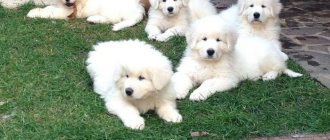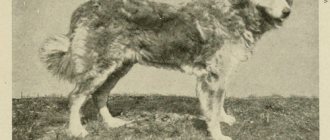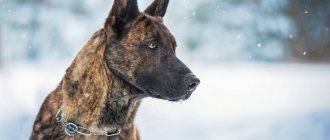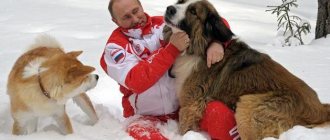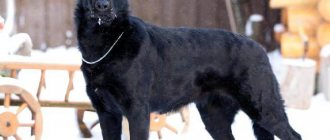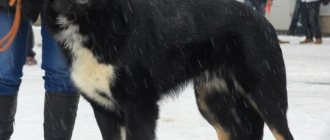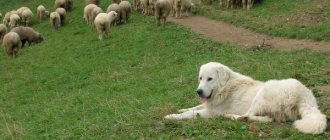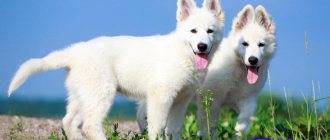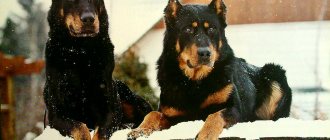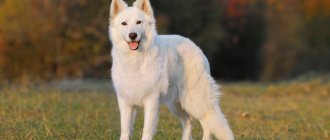History of the Maremma-Abruzzese Sheepdog breed
The Maremma-Abruzzian Sheepdog got its name from two historical regions of Italy - Maremma and Abruzzo.
For a long time, the regions argued among themselves for the right to be considered the homeland of dogs. But since the conflict dragged on, and there was no advantage in either side, dog handlers had to compromise and include both areas in the name of the breed. As for the first mentions of giant white-haired shepherd dogs, they can be easily found in the works of the ancient Roman authors Rutilius Palladius and Lucius Columella. Describing the peculiarities of farming in the territories of the Eternal City, both researchers noted white dogs that deftly manage herding and driving sheep. Sculptures and frescoes depicting the first maremmas also survive. You can appreciate the appearance of the ancestors of today's shepherd dogs in the Archaeological Museum of Capua, the British Museum (look for the figure called Jennings's Dog/Duncombe's Dog), the Church of Santa Maria de Novella in Florence, and the Temple of San Francesco in Amatrice. If you happen to visit the exhibition of paintings from the Vatican Pinacoteca, be sure to look for the painting “The Nativity” by the medieval painter Mariotto di Nardo - it depicts a Maremmo-Abruzzese shepherd dog very realistically.
The breed began to be registered in stud books in 1898 - at the time of the procedure, documents were issued to only 4 individuals. In 1924, the animals received their first appearance standard, compiled by Giuseppe Solaro and Luigi Groppi, but subsequently, until 1940, shepherd dogs were no longer involved in registration. It is also worth paying attention to the fact that until the middle of the 20th century, dogs from Maremma and dogs from Abruzzo were positioned as two independent breeds. This was explained by the fact that historically individuals from these regions very rarely contacted each other, developing in isolation. The mixing of phenotypes occurred only during the movement of livestock across the country - shepherd dogs accompanied sheep, entered into contact with dogs from other areas and produced mixed-breed puppies along the way. The unification of the breed clans into one family called the Maremma-Abruzzese Shepherd Dog occurred only in 1958, at the insistence of the same Giuseppe Solaro.
Breed standard Maremma-Abruzzese Sheepdog
Maremma is a respectable, but by no means overweight, “blonde”, who inspires respect with his impressive, noble appearance. External nervousness and feigned suspicion are not inherent in the breed, so the facial expression of shepherd dogs is more concentrated and attentive than stern. The physique of representatives of this family is moderately elongated, but at the same time balanced. Males are noticeably larger and heavier than females. The standard height of a purebred “boy” is 65-73 cm, weight – 35-45 kg. “Girls” weigh 30-40 kg with a height of 60-68 cm.
Head
The shape of the skull of the Maremma-Abruzzese Shepherd Dog resembles a polar bear. The head itself is in the form of a cone, large, without relief outlines. The rounded cheekbones stand out well on the wide skull. There is a noticeable divergence between the line of the head and the upper line of the muzzle, forming a convex profile pattern. The occipital protuberance and brow arches are clearly marked. The frontal sulcus, on the contrary, is greatly smoothed. The stop is implicit. The muzzle is approximately ⅒ shorter than the skull.
Jaws, lips, teeth
Impressive jaws with massive, evenly set incisors. The teeth are white, healthy, forming a correct scissor bite in the bow. The lips of the Maremma-Abruzzese Sheepdog lack the fleshiness characteristic of many large breeds, so they barely cover the teeth. As a result: if you examine an animal with its mouth closed in profile, only the corner part of the lips, painted in a rich black tone, will be noticeable.
Eyes
Despite its more than impressive dimensions, the Maremma has small eyes. The iris color is usually ocher or chestnut blue. The eyeballs themselves are not convex, but they are not deep-set either. The black-rimmed eyelids have an elegant almond-shaped cut. The look of the breed is intelligent and insightful.
Ears
The ear tissue of the Maremma-Abruzzese Shepherd is characterized by excellent mobility and a hanging position. The ears are set above the cheekbones, that is, very high. The size of the ear membrane is small, V-shaped, with a pointed tip. The length of the ear does not exceed 12 cm. An important nuance: today’s maremmas do not have their ears cropped. The exception is individuals who continue to perform herding service.
Nose
The large black lobe with wide nostrils should not extend beyond the front edges of the lips.
Neck
A purebred shepherd's neck is always ⅕ shorter than its head. The neck itself is thick, without dewlap, remarkably muscled and forms an arch-like bend in the upper part. This part of the body is very abundantly furred, as a result of which the fur closer to the chest forms a rich collar.
Frame
The body is strong, slightly elongated. The rounded, tapering chest descends to the elbow joints. The back is straight from the wide, raised withers to the croup, then slightly sloping. The lumbar part is shortened and does not protrude beyond the upper dorsal line. The croup is powerful, with a good slope: the angle of inclination in the area from the base of the tail to the hip is 20°. The bottom line is arched with a tucked belly.
Legs
The back and front legs of the Shepherd are in balance with the body and have an almost straight posture. The scapular areas have developed muscle mass and elongated contours, the shoulders stand at an angle of 50-60° and are pressed closely to the sides. The forearms are longer than the shoulders and are located almost vertically, the metacarpal joints are thickened, with a clearly defined protrusion of the pisiform bones, the size of the metacarpus is necessarily ⅙ of the length of the front leg.
In the Maremma-Abruzzese Sheepdog, the hips are located at an angle (direction from top to bottom). The lower leg is shorter than the femur, but with strong bones and lean muscles. The hock joints are thick and wide. The hocks are strong, dry, and always without dewclaws. The dog's paws are round, the toes are closed, and the claws are black. A less preferred option is chestnut claws.
Tail
Since the Maremma-Abruzzese Sheepdog's croup is characterized by a strong slope, the base of the dog's tail has a low set. When at rest, the tip of the tail hangs below the level of the hocks. In a moving shepherd, the tail is raised no higher than the upper part of the back, and the tip is noticeably curved.
Wool
The Maremma dog's coat resembles a horse's mane. The hair is long (up to 8 cm), quite hard, abundant and uniform on all parts of the body. It is desirable to have a collar on the chest and feathering on the hind legs. Slight waviness of the coat is not considered a defect. The hair on the head, muzzle, front of the paws and ears is very short. In winter, a thick undercoat grows on the body, which disappears by summer.
Color
The ideal Maremma is a dog with snow-white fur. It is undesirable, but acceptable, to have areas on the body colored in ivory tone, or in light red and yellowish-lemon colors.
Disqualifying faults
- Nose devoid of pigmentation.
- Aggression. Unreasonable cowardice.
- The muzzle is convex or concave.
- Pronounced jaw overshot.
- Strabismus, unevenly colored iris, eyelids without pigment.
- Short or completely absent tail.
- Curly wool.
- Solid isabella color, as well as the presence of spots of this shade and black hairs.
Character of the Maremma-Abruzzese Shepherd Dog
The security activities of maremmas should not be confused with the working techniques of wolfhounds. Historically, the breed was bred to scare away enemies from the herd - there was never any talk of entering into battle with predators and thieves who decided to feast on free lamb. Usually the dogs worked in a group: each participant in the action had his own observation post, which helped to repel the enemy’s attack in a timely manner. Modern Maremma-Abruzzese Shepherd Dogs have retained the guard instincts of their ancestors, which could not but leave an imprint on their character.
All representatives of the family of today's maremmas are serious and proud creatures who periodically have problems with subordination. It cannot be said that these “Italians” are the most difficult shepherd dogs to train, it’s just that unconditional obedience is not their strong point. The dog considers a person in general and the owner in particular to be his equal, therefore, all attempts to “suppress” the animal with his authority can be considered obviously a failure.
Maremma-Abruzzese Shepherd Dogs are condescending only towards children, patiently enduring their stroking and suffocating hugs. True, such goodwill does not extend to an unfamiliar baby, so if you are visited by friends with a not particularly well-mannered child, it is better to isolate the dog - the Maremma may react to the pranks of someone else’s offspring in an unexpected way.
The breed has a fairly good memory, supported by selectivity in communication. Usually the dog peacefully greets guests who have previously appeared on the doorstep of the house and are remembered for their exemplary behavior. The animal suspects strangers and family friends who previously provoked the pet into conflict of all mortal sins and scans them with a pointedly hostile gaze.
Maremmas have no hunting habits as such, so the breed does not pose a danger to other domestic animals. Moreover, living side by side with other representatives of the fauna awakens ancient instincts in the shepherd. As a result: the maremma begins to “herd” chickens, ducks, cows and in general any living creature, including penguins.
Character and behavior
As befits a guard dog, the Maremmo-Abruzzese Shepherd Dog will never find itself in the role of a subordinate. This is a proud, self-sufficient breed, ready to work as an equal, but not as a follower. Having found an owner, this shepherd becomes a faithful friend and wise partner. She does not recognize groundless power and is guided only by her own instincts. By the way, they have been honed over centuries, so they do not pose any difficulties in education. A dog respects only an authoritative owner. The behavior of a shepherd dog is tailored to the protection of property and livestock. But she does not guard blindly. Acute intelligence allows the breed to assess the situation and voice only when necessary.
Maremma has a keen intellect
On a note! An example of this would be behavior during the day and at night. If during daylight hours the breed allows guests to enter the area entrusted to it, then at night any visit will be warned.
When analyzing a situation, the dog is able to look back at the owner’s reaction. It does not rush into battle thoughtlessly and does not try to curry favor with its owner through its aggressive behavior. She is wary of strangers and always assesses the degree of danger by observing those who come. She is able to identify an intruder even in a crowd, which she will definitely announce by barking.
A distinctive feature of the Maremma is the ability to classify people. She is kind to her friends and frequent guests. The stranger will definitely be checked for sincerity. It is impossible to appease her. The dog perceives any manipulations from a potential enemy categorically. The Shepherd always has a good relationship with members of the household. She is ready to accompany one owner, but does not intend to deprive others of attention.
The Maremmo-Abruzzese Sheepdog recognizes only one owner
The trembling of a dog’s soul can be observed when it communicates with children. For an animal, these are separate creatures, fragile and defenseless. In games, the Maremma is patient and resilient. Never raises a voice or uses force. It is impossible to unbalance this dog without its consent.
It is worth considering that only the master’s children belong to the adored caste. Other people's babies can irritate an alert dog. The breed does not like running around and making noise, so it perceives strangers as a potential danger.
Maremma gets along well with dogs of other breeds and other animals
Attention! Responsibility of the breed is its calling card. Being in the role of a plush toy, the dog does not lose sight of the surrounding situation for a moment, ready at any moment to defend “its” person. The dog makes decisions with lightning speed. And they rarely turn out to be wrong.
Treat Maremma pets with patience. Being a very wise dog, she can even get along with cats. The same behavior is observed on the street. A socialized dog never shows aggression towards strangers who have nothing to do with it.
Maremma gets along well with children, but only with the master's
An exception may be the period of sexual hunting, when the male shepherd is not averse to fighting with the enemy in the fight for the female.
Education and training
The slight detachment of behavior and reluctance to blindly follow the owner in maremmas was formed deliberately. Historically, contact between puppy and owner was kept to a minimum, and individuals that became friendly with humans were often discarded. At the age of one and a half months, maremmas were already placed in a pen with sheep so that they learned to protect their “flock” and lost the habit of communicating with the owner. This helped to train the shepherd dogs to be responsible defenders capable of making independent decisions, but not the most obedient servants.
There is an opinion that Maremma-Abruzzese Shepherd Dogs, in principle, are not aimed at remembering commands, so if the pet manages to develop adequate behavior in response to the demands of “Come to me!” and “Sit!”, this is already a great achievement. In fact, everything is not so sad. Yes, maremmas are not servants and, when faced with the choice of protecting the territory or rushing after the stick abandoned by the owner, they will always choose the first option. However, it is possible to train them. In particular, with a six-month-old puppy you can easily complete the OKD course. The training methodology is the same as for all shepherd dogs - Maremmas do not need exceptions or concessions.
A very important nuance is punishment. No physical pressure should be applied, no matter how the puppy provokes it. And the point here is not in the subtle mental organization of the dog. It’s just that the Maremma-Abruzzese Shepherd Dog will never forgive you for a blow and will stop recognizing your authority after the first execution. The most difficult period in the life of every owner of a male Maremma is the age of 7-9 months. This is the period of puberty, when the puppy grows up and begins to encroach on the title of head of the house.
You will have to deal with a grown-up hooligan more strictly, but without assault. A short leash is effective for disciplining your pet. Training at this time is not canceled, but is carried out in the standard mode, but with more stringent requirements. Another “cure” for disobedience is a demonstration of physical superiority. This approach is used only in a situation where the dog challenges the owner to an open confrontation. Usually, to sober up an overbearing animal, a push in the chest (not to be confused with a blow) or a sharp tug of the leash is enough.
In articles devoted to training the breed, inexperienced owners are strongly advised to resort to the services of a professional dog handler. However, do not rush to blindly follow the recommendations: a professional Maremma, of course, will teach you, but she will mainly obey him, and not you. If you want to get a well-mannered and adequate dog, train it yourself, and take your pet to classes with a canine trainer a couple of times a week to get useful advice and correct mistakes.
Training and walks
The Maremmo-Abruzzese Shepherd is a pleasure to train, although they can be stubborn at times. They grasp everything new and interesting on the fly, this is especially noticeable in the process of training small puppies. It is important to start socializing your pet as early as possible after quarantine.
The dog is put on a leash and led “in public” : through noisy streets, entering unfamiliar entrances, riding in a car and on public transport.
The earlier training begins, the fewer problems there will be with aggression towards the owner during the period when the dog’s character is developing. The dangerous period from 6 months to 2 years will pass painlessly, and the dog will obey the owner unquestioningly only if the owner constantly demonstrates his superiority.
The puppy must know that the owner is the main and all-powerful being in the world, and all members of the household are under his protection. Any growling or attempt to stand up with your chest to defend your piece of food or the right to lie on the master’s bed must be immediately and harshly suppressed .
The best way to demonstrate your superiority is to lift the dog by the skin, after which you need to press the dog to the ground and hold it until it begins to resist. It is clear that this is much easier to do with a puppy than with a forty-kilogram teenager.
Maintenance and care
The Maremma-Abruzzese Shepherd Dog is a kennel-yard type dog. It is also possible to meet representatives of the breed who have managed to get used to living in a city apartment, but it is important to understand that in such cases the animals simply adapt to the situation. We are not talking about any full life in cramped conditions.
The ideal option is when the pet can move freely from the house to the yard and back. Maremmas are also not designed for life on a chain: such restrictions break the shepherd’s psyche, turning it into an embittered and uncontrollable creature. The breed does not require intense physical exercise, but an adult dog needs to exercise by walking twice a day. A Maremma is supposed to be walked for 1.5-2 hours, in any weather, so for inactive owners, the Abruzzo Shepherd Dog is not the most suitable option.
Hygiene
The coat of the Maremma Abruzzese Sheepdog is considered self-cleaning. This means that the dog is capable of getting dirty, but this condition will not radically affect its appearance. Dirt sticks to Maremmas in rainy weather, and only the dog’s coat gets wet, while the undercoat remains dry and clean in any case. The breed's coat does not become tangled if the dog is healthy and is at least minimally cared for.
Male shepherds shed once a year; with females, such transformations can occur more often, especially during gestation and birth of puppies. Many breeders recommend bathing the Maremma at the very beginning of shedding - this speeds up the process of coat change. In other cases, it is better to replace bathing with systematic dry or wet brushing - during the period between shedding, Maremma-Abruzzese Shepherd Dogs hardly lose hair.
Puppies need to be brushed more often, ideally daily. In order for junior wool to be replaced more quickly by adult wool, you need to purchase a slicker coat. Maremma babies do not like this device, but with regular use they quickly learn to tolerate it. Puppies have their nails trimmed every two weeks, and adults’ nails once a month. Systematic hygiene of the Maremma's ears and eyes is also mandatory. No specific skills are required for this. You need to remove dust bunnies from the corners of your eyelids daily with a damp cloth, and clean your ears once a week with a napkin moistened with a special lotion.
Feeding
The breed is suitable for a natural diet, which should be based on any lean meat and offal. Heat treatment of meat is not required, since raw animal protein is healthier for shepherds. You can supplement the menu for maremma with frozen boneless sea fish, low-fat cottage cheese and yogurt. Eggs can be given no more than 1-2 times a week. Be sure to make shavings for your pet from raw fruits and vegetables - apples, pumpkins, carrots, zucchini. Such salads can be seasoned with sour cream, unrefined sunflower oil or fish oil. For porridges with meat, it is better to use buckwheat, rice and oatmeal.
There must be a bowl of water freely available, and a bowl with lunch and dinner is given to the pet for a strictly defined time. If the dog does not want to finish the portion, the food is removed. This approach allows you to discipline the animal and quickly accustom it to the regime. From 1.5 to 2 months, Maremma-Abruzzese Shepherd puppies are fed six times a day. From 2 to 3 months - five times a day. By 3 months, it is recommended to reduce the number of feedings to four per day. From 4 to 7 months, the maremma is fed three times a day. An 8-month-old puppy is considered an adult, so his puppy's bowl is only filled with food twice a day.
Important: do not be impressed by the impressive dimensions of the breed and do not try to increase the standard portion of food - the shepherd dog should not become fat and expand in width, which will create additional problems for the joints.
How to choose a puppy
- If you do not plan to raise a working shepherd dog from a Maremma to guard livestock and property, look for breeders who breed show and domestic lines of the breed. Their charges are more focused on human contact and less suspicious of others.
- A good Maremma puppy is a brave puppy! If at the entrance to the nursery you are barked by a four-legged shaggy ball, you can rest assured that in the future he will grow into a brutal and stern watchman.
- It is not advisable to take a pair of same-sex puppies: both in work and in everyday life, Maremma males and females get along better with representatives of the opposite sex.
- Assess the living conditions of the puppies in the kennel: dogs should not be locked up and afraid of people. An unpleasant smell in the room where animals live is also not the best characterization of the breeder.
- It will be a great advantage if sires have their litter tested for genetic joint dysplasia.
- Always check the age of the manufacturers. Keep in mind that Maremma Abruzzese Shepherd bitches are allowed for breeding from the age of 18 months and finish their breeding “career” by the age of 8 years.
- Find out from the seller what the litter of puppies is for the year. Ideally, a maremma breeds once every 12 months. In some cases, two litters per year are allowed - FCI no longer registers more than that.
About the nursery
I first saw the Maremmo, an Abruzzese shepherd dog, in 2014. It was love at first sight. Shortly after that we got our first dogs. My initial feelings for these magnificent dogs grew and grew stronger along with them. I still am amazed by their ability to learn, tenderness and love towards people, curiosity and high efficiency. At the same time, maremmas are excellent guards. When communicating with my dogs, I often completely forget about time! There are five adult maremmas in our nursery. Our dogs attend exhibitions, and quite effectively, both in our country and abroad. The pride of our kennel is our leading male sire Silver House Lucin (Luciano) - one of the most titled maremmas in Russia and abroad. All our dogs have an excellent psyche, without aggression, which is very important, because the dogs are quite large. We and our dogs feel equally comfortable on walks, in OKD classes, and in handling and grooming halls. We believe that we chose the breed for ourselves very correctly. After all, as the years pass, we love our dogs more and more. With each dog we discover new facets in the communication and purpose of these white beauties, whose name is MAREMMO - ABRUZZ SHEPHERD DOG!
Be sure to read the information below before meeting our babies! All puppies of our Kennel, WITHOUT exception, are obtained as a result of thoughtful combinations of blood from high-pedigree sires. Absolutely healthy, tested for the absence of major genetic diseases for many generations, repeatedly titled parents, all this is a serious guarantee of the quality of any of our Silver Haus pupils, pets or future show champions. We value the name of the Kennel and our reputation, being responsible for EVERY Silver Haus puppy. The nursery sets the task of finding the best hands for our kids to go through the path of education and development TOGETHER with you. Call the Nursery for details!
Graduates of the nursery live in many countries of the world (Germany, Finland, India, Vietnam, Azerbaijan, Belarus), as well as in many regions of Russia, successfully exhibit and have numerous titles of Country Champions!!!
Silver Haus Lyuchin (Luciano) - the puppies' father is a highly titled, handsome male, with an excellent psyche and breed characteristics, which he passes on to the children!
Esenia is a mother of puppies, a beautiful maremma breed!
- Our pedigrees include Champions of the World, Eurasia, Russia and Champions of large prestigious exhibitions!!!
ROMUL ONEYROS, KLEOPATRA, ALFEI, BRETIA, ROMUL GELORA, ROMUL NURSIA, ROMUL ENEY, DREVNEE BRATSTVO NASKA, NAVARRO DEGLI ELMI, ELIA DEGLI ELMI - these are the maremmas with which the history of the breed in Russia began!!!
Ayman - Silver Haus Lyuchin (Ayman & AnimaArdente) , in the ranking of the most titled maremmas in Russia, winner of many large, prestigious exhibitions! The most beautiful Maremma I've ever seen!!!
Owner: Victoria Mileshina
Drevnee Bratstvo Ratibor - father of Esenia (mother of puppies), in the ranking of the most titled maremmas in Russia, also winner of the largest prestigious exhibitions! Maremma legend!!!
Owner: Svetlana Smirnova
Our previous litter “D”, which is already 2 years old, and the current litter “E” for Inbreeding :
- DREVNEE BRATSTVO RATIBOR — 3 : 2
- ROMUL NURSIA — 4 : 4
- ROMUL ENEY — 4 : 4
